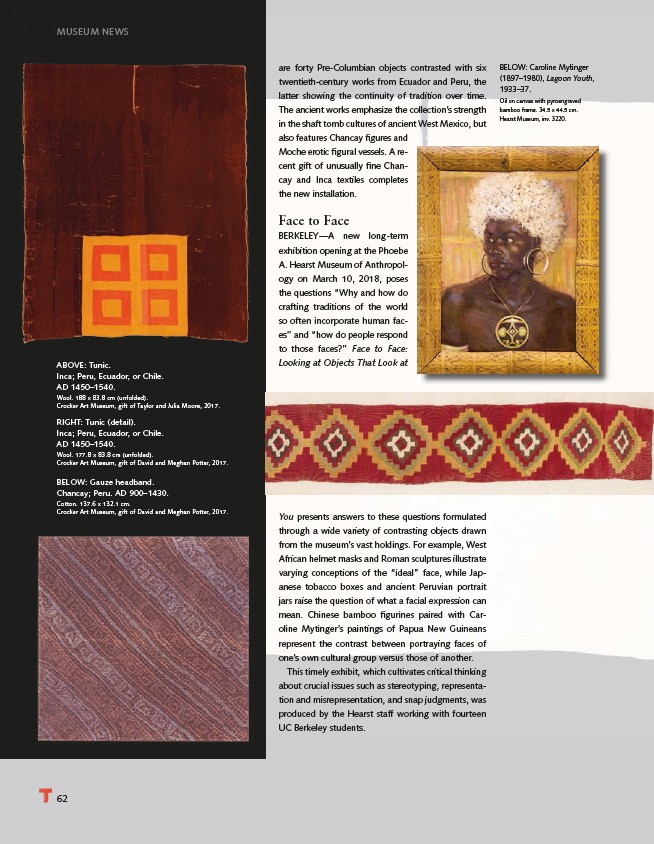
ABOVE: Tunic.
Inca; Peru, Ecuador, or Chile.
AD 1450–1540.
Wool. 188 x 83.8 cm (unfolded).
Crocker Art Museum, gift of Taylor and Julia Moore, 2017.
RIGHT: Tunic (detail).
Inca; Peru, Ecuador, or Chile.
AD 1450–1540.
Wool. 177.8 x 83.8 cm (unfolded).
Crocker Art Museum, gift of David and Meghan Potter, 2017.
BELOW: Gauze headband.
Chancay; Peru. AD 900–1430.
Cotton. 137.6 x 132.1 cm.
Crocker Art Museum, gift of David and Meghan Potter, 2017. You presents answers to these questions formulated
62
through a wide variety of contrasting objects drawn
from the museum’s vast holdings. For example, West
African helmet masks and Roman sculptures illustrate
varying conceptions of the “ideal” face, while Japanese
tobacco boxes and ancient Peruvian portrait
jars raise the question of what a facial expression can
mean. Chinese bamboo fi gurines paired with Caroline
Mytinger’s paintings of Papua New Guineans
represent the contrast between portraying faces of
one’s own cultural group versus those of another.
This timely exhibit, which cultivates critical thinking
about crucial issues such as stereotyping, representation
and misrepresentation, and snap judgments, was
produced by the Hearst staff working with fourteen
UC Berkeley students.
BELOW: Caroline Mytinger
(1897–1980), Lagoon Youth,
1933–37.
Oil on canvas with pyroengraved
bamboo frame. 34.5 x 44.5 cm.
Hearst Museum, inv. 3220.
are forty Pre-Columbian objects contrasted with six
twentieth-century works from Ecuador and Peru, the
latter showing the continuity of tradition over time.
The ancient works emphasize the collection’s strength
in the shaft tomb cultures of ancient West Mexico, but
also features Chancay fi gures and
Moche erotic fi gural vessels. A recent
gift of unusually fi ne Chancay
and Inca textiles completes
the new installation.
Face to Face
BERKELEY—A new long-term
exhibition opening at the Phoebe
A. Hearst Museum of Anthropology
on March 10, 2018, poses
the questions “Why and how do
crafting traditions of the world
so often incorporate human faces”
and “how do people respond
to those faces?” Face to Face:
Looking at Objects That Look at
MUSEUM NEWS